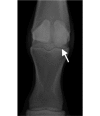A retrospective study of radiographic abnormalities in the repositories of 2-year-old Thoroughbred in-training sales in Japan
- PMID: 27330400
- PMCID: PMC4914399
- DOI: 10.1294/jes.27.67
A retrospective study of radiographic abnormalities in the repositories of 2-year-old Thoroughbred in-training sales in Japan
Abstract
This study aimed to evaluate the influence of radiographic abnormalities of 2-year-old Thoroughbred horses that were listed at in-training sales in Japan, on whether they started to race or not at 2-3 years of age. Radiographs of 850 2-year-old Thoroughbreds in the in-training sales repository from 2007 to 2010 were reviewed, and 26 categories of radiographic abnormalities were found. Forty-three horses (5.1%, 43/850) did not start a race at 2-3 years of age. In accordance with the racing results for this age category, as determined by Fisher's exact test and multiple logistic regression analysis, none of the radiographic abnormalities were significantly related to failure to start a race. At 2 years of age, 198 horses (23.3%, 198/850) did not start a race. Horses with enlargement of the proximal sesamoid bones in the fore (9 of 19 horses) and hind limbs (5 of 9 horses) did not start a race at the age of 2 years, and fewer of these horses (fore, P=0.021; hind, P=0.030) started a race at the age of 2 years compared with the population of horses without these radiographic abnormalities. These results suggest that identification of radiographic enlargement of the proximal sesamoid bones during training sales could derail the racing debut of horses at the age of 2 years. However, this might not necessarily indicate a poor prognosis and resulting in retirement from racing at 2-3 years of age.
Keywords: Thoroughbred; prognosis; radiography; repository; sales.
Figures

Similar articles
-
A retrospective study of radiographic abnormalities in the repositories for Thoroughbreds at yearling sales in Japan.J Vet Med Sci. 2017 Nov 10;79(11):1807-1814. doi: 10.1292/jvms.16-0425. Epub 2017 Oct 6. J Vet Med Sci. 2017. PMID: 28993565 Free PMC article.
-
Radiological findings in the proximal sesamoid bones of yearling and 2-year-old Thoroughbred sales horses: Prevalence, progression and associations with racing performance.Equine Vet J. 2025 Jan;57(1):87-100. doi: 10.1111/evj.14051. Epub 2024 Jan 18. Equine Vet J. 2025. PMID: 38237926 Free PMC article.
-
Effects of various presale radiographic findings for yearling Thoroughbreds on 2-year-old racing performance.J Am Vet Med Assoc. 2012 Dec 1;241(11):1505-13. doi: 10.2460/javma.241.11.1505. J Am Vet Med Assoc. 2012. PMID: 23176245
-
Radiographic changes in Thoroughbred yearlings. Part 2: Associations with racing performance.Equine Vet J. 2003 Jun;35(4):366-74. doi: 10.2746/042516403776014307. Equine Vet J. 2003. PMID: 12880004
-
Correlation of racing performance with radiographic changes in the proximal sesamoid bones of 487 Thoroughbred yearlings.Equine Vet J. 2003 Jun;35(4):350-3. doi: 10.2746/042516403776014262. Equine Vet J. 2003. PMID: 12880002
References
-
- Butler J.A., Colles C.M., Dyson S.J., Kold S.E., Poulos P.W. 2000. Foot, pastern and fetlock. pp. 27–130. In: Clinical Radiology of the Horse, 2nd ed., Blackwell Publishing, Oxford.
-
- Carmalt J.L., Borg H., Näslund H., Waldner C. 2014. Racing performance of Swedish Standardbred trotting horses with proximal palmar/plantar first phalangeal (Birkeland) fragments compared to fragment free controls. Vet. J. 202: 43–47. - PubMed
-
- Cohen N.D., Carter G.K., Watkins J.P., O’Conor M.S. 2006. Association of racing performance with specific abnormal radiographic findings in Thoroughbred yearlings sold in Texas. J. Equine Vet. Sci. 26: 462–474.
-
- Colón J.L., Bramlage L.R., Hance S.R., Embertson R.M. 2000. Qualitative and quantitative documentation of the racing performance of 461 Thoroughbred racehorses after arthroscopic removal of dorsoproximal first phalanx osteochondral fractures (1986–1995). Equine Vet. J. 32: 475–481. - PubMed
LinkOut - more resources
Full Text Sources
Other Literature Sources
